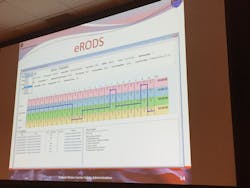There are more than a few questions regarding the federal policies and procedures surrounding day-to-day operation of electronic logging devices (ELDs) – especially how the data recorded by those devices will be provided to law enforcement officers and/or safety officials during roadside inspections.
Joe DeLorenzo, director of the office of compliance and enforcement at the Federal Motor Carrier Safety Administration (FMCSA), provided updates on that data transfer issue and clarified a few other minor “tweaks” to the agency’s ELD guidelines during a presentation at TMW Systems and PeopleNet's 2017 in.sight yuser conference and expo in Nashville, TN.
First, there will be two options when it comes to electronically transferring a driver’s record of duty status (RODS).
Option 1: Web Service and direct Email. The primary avenue FMCSA believes will be used to transfer data is via a “web service” set up by agency. The driver will send his or her RODS data via email to a web service hosted by the agency with a unique key code. The law enforcement/safety official can then log into the web service and, using that unique code, retrieve the driver’s electronic logbook data, which will be dubbed an “eRODS.” Alternatively, the driver can email their “eRODS” information directly to the officer, though DeLorenzo doesn’t think that transmission option will be used much.
Option 2: USB and Bluetooth. The use of a USB, short for “Universal Serial Bus,” is another transfer method on the table. In this case, the official provides the driver with a USB upon which the driver plugs loads his or her RODS data from their ELD. Alternatively, the driver can make their ELD “searchable” to the official by using a Bluetooth or wireless connection.
“I think in 99.9% of the [roadside cases] we’ll see officials use the web services method,” DeLorenzo explained during his presentation.
But what happens if those transfer methods don’t work?
That’s why one of the performance specifications for an ELD includes the need for it to “graphically display” RODS data from a “reasonable distance” – either via a view screen or via a paper printout – so safety officials can clearly read the data.
“This is also why ELDs should not be permanently fixed in the cab; you don’t want a cop to have climb up into the truck to read it,” he said.
DeLorenzo also provided a few updates and clarifications for some of the other parts of the ELD rule.
Those “graphical display” options also may be end up being more critical than many think, as DeLorenzo said the FMCSA’s eRODS system is still being tested and is not likely to be deployed before December this year.
Indeed, Dave Osiecki, president of Scopelitis Transportation Consulting, noted in a separate presentation that FMCSA plans to distribute training materials on how to use the eRODS system to the 14,000 or so Commercial Vehicle Safety Alliance (CVSA)-trained inspection officials sometime in November – which, in his words, “doesn’t provide a very big window” for learning how to use the system properly.
FMCSA’s DeLorenzo also touched on several important clarifications to other facets of the rules governing use by motor carriers and owner-operators.
ELD exemptions: drivers holding a commercial driver’s license (CDL) remaining with a 100 mile air-radius of their home base, and non-CDL freight drivers remaining within a 150 mile air-radius of their home base may still use timecards. Outside of those areas, CDL drivers can use a paper logbook for RODS data for not more than eight days during a 30-day period. Vehicles manufactured before model year 2000 and drivers conducting “drive away-tow away” operations do not need ELDs either.
However, DeLorenzo made some important clarifications where the eight-day paper logbook exemption is concerned; an exemption he referred to as the “8/30” rule.
First, the 30-day period is a “continuous clock” and not a one-month period. It is also an exemption that can be taken on a per-driver basis, meaning several drivers in a fleet can use it even if the others must use ELDs. Those eight days don’t have to be continuous, either – the rule allows for any eight days in the 30 day period to be logged via paper records.
Yet DeLorenzo cautioned that using the 8/30 exemption is not as simple as it might seem.
“It takes planning to use this exemption; you need to think about how you are going to use it,” he stressed. “You don’t want to be thinking about it on the seventh day of your eight-day period.”
AOBRD and EOBR limitations: As it stands right now, fleets that deploy automated onboard record devices (AOBRDs) or electronic onboard records (EOBRs) can be “grandfathered” under the regulation, thereby getting an extra years within which to deploy ELDs.
One reason that AOBRDs and EOBRs will eventually be cycled out is that they are not designed to be connected to a truck engine’s electronic control module or ECM, which is how ELDs will track vehicle mileage and match that up to a driver’s hours of service (HOS) log.
But there’s a catch, DeLorenzo warned: “Those devices must be ‘in use’ on December 18 when the ELD mandate goes into effect; they can’t be sitting on a shelf and deployed after that date,” he said.
DeLorenzo noted that AOBRDs and EOBRs in use prior to December 18 can be transferred to other vehicles and remain in use after the deadline. But new trucks placed into service after December 18 must be equipped with ELDs, he stressed.
Yard moves: One ticklish question when it comes to ELDs is how to account for so-called “yard moves,” when trucks are moved from dock to dock, into and out of maintenance facilities, or transferred to different parking spots within a defined area within and around a freight terminal or repair shop. Multiple people often operate trucks in those circumstances, often other than the driver typically assigned to haul freight with them.
DeLorenzo said the critical factor to remember is that while none of those “yard moves” counts against a driver’s HOS records, the mileage accrued and tracked by the ECM must be accounted for.
“It’s all about properly accounting for the miles a vehicle is accumulating when not in freight service transportation,” he emphasized.
Driver movement between AOBRDs, EOBRs, and ELDs: DeLorenzo pointed out that there is no “interoperability” rule governing data-sharing between those three devices. He also suspects there will be many “mixed fleet” situations after December 18 where some trucks are equipped with AOBRDs and EOBRs, while others feature ELDs.
“Many drivers will probably find themselves switching back and forth between the two,” he said. “The number one thing they need to remember is to stay in compliance with the HOS rules.”
That means they need to have on hand a log of their previous eight days and know how to use the electronic recording device in the cab, DeLorenzo said.
“It’s also important to figure out a plan as to what happens if they have a breakdown on the road and need to switch to a new vehicle entirely,” he added.
About the Author
Sean Kilcarr
Editor in Chief
Sean Kilcarr is a former longtime FleetOwner senior editor who wrote for the publication from 2000 to 2018. He served as editor-in-chief from 2017 to 2018.


